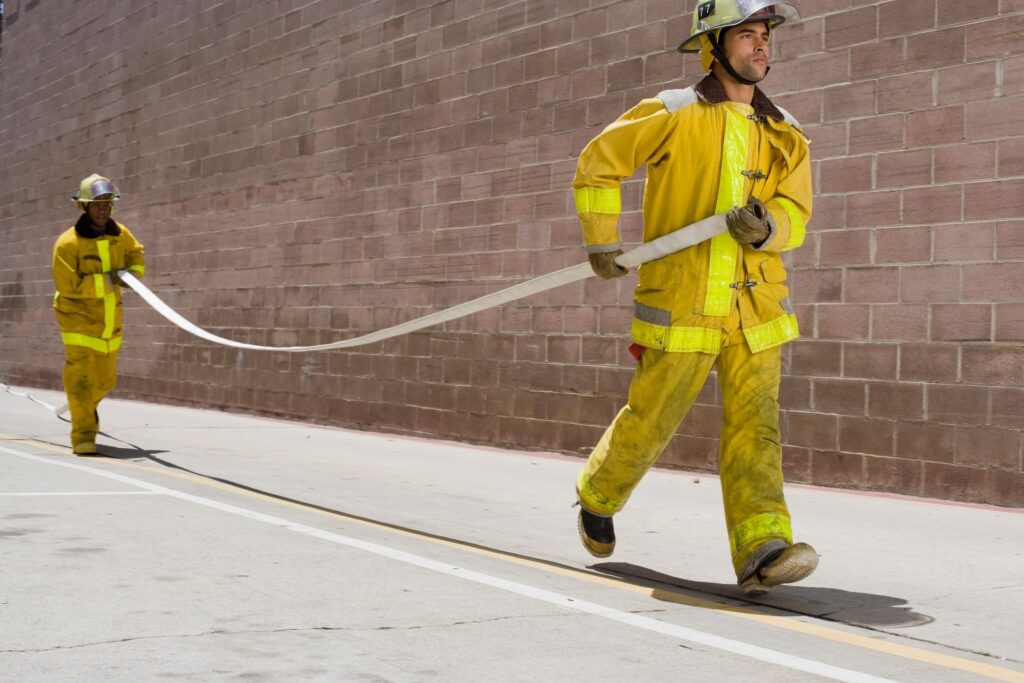
There have been many home fires on the news lately where entire families are hurt or killed. The tragedy is most fires are preventable. Actually, 95% of home fires are preventable and almost always caused by user error.
One of the first steps to fire prevention is ensuring that you have the correct number of smoke alarms in your home. You should have a smoke alarm on every level of your home and in every living space, basement included. Your smoke alarms should then be checked monthly and batteries replaced two times a year. Additionally, fire extinguishers should be located on every floor of the home, in a place that is readily accessible in the event of a fire.
A home fire escape plan is essential because when a fire breaks out, every second counts. A fire can turn life-threatening in 30 seconds. And the majority of fires break out late at night or early in the morning when everyone is asleep, so your family needs to know what to do before an emergency happens. Create multiple escape plans and practice them. Your plans should include escape routes from different areas of the house, tools for exiting the building (escape ladders, items to open, break out windows), and a designated meeting place. It’s very important to practice fire safety with your kids, so be sure to familiarize your children with the sounds of the alarms.
Faulty electrical outlets and outdated appliances cause most electrical fires. If your electrical outlets are old, have them replaced by a master electrician. Tips to help identify issues:
- Warmth or Heat. Use your hands to feel the outlet. If you detect any warmth or notice signs of scorching or melting on the plastic, replace it immediately.
- Smoke. Smoke from any electrical outlet is an indicator it’s a significant fire danger.
- Loose Connections. If any outlets are loose in the wall or they no longer hold a plug tightly (the plug falls out when plugged in), replace the outlet.
- Sounds. If you hear buzzing or popping sounds coming from an electrical outlet, turn off the power to that part of your home and immediately call a licensed electrician.
- Frayed Wires. Take off your electrical outlets’ plastic covers and examine the wiring. Wires can crack or fray from age, heat, or bending. Nails or screws can also pinch them. If you see any damage to the outlet’s wires, call an electrician.
Gas appliances should be maintained. Check your water heater, gas stove, furnace and dryer once a year to make sure all the appliances’ connections to gas lines are in working order, and that the gas lines themselves are in good condition. Many homes use natural gas for cooking, heating water, and powering the furnace. A leak in the natural gas lines or fittings could result in an explosion. Natural gas has no odor of its own, so they add an odorant that smells of rotten eggs for safety.
If you smell natural gas, get your family out of your home immediately and call 911. Never call for help while still inside the home. The sparks generated from the phone could cause an explosion.
2,900 home clothes dryer fires are reported each year and cause an estimated 5 deaths, 100 injuries, and $35 million in property loss. Dryer lint that accumulates in your dryer’s removable filter is flammable. If the lint isn’t removed on a regular basis, it can cause a fire. Also, check for and remove lint buildup around the dryer’s exhaust hose at least once a year.
Cooking fires are a huge cause of home fires as well as home fire injuries. The majority of cooking equipment fires start with the ignition of common household items (i.e., wall coverings, paper or plastic bags, curtains, etc.).
- Stay in the kitchen while you’re frying, grilling, boiling, or broiling food. If you have to leave the room—even for just a moment—turn off the stove.
- Keep anything that can catch fire, such as food packaging, oven mitts and towels, away from your stovetop.
- Make sure you have the correct type of extinguisher and know how to properly use it.
- Crumbs in a toaster, built-up grease on the stovetop, and excess dust behind your appliances are fire hazards.
- Let grease cool before disposing of it in the garbage. Never pour grease or oil down the drain
Each year, candle fires account for hundreds of thousands of dollars in property damage and hundreds of unnecessary injuries and deaths.
- Never leave candles unattended.
- Don’t use candles in the bedroom, or anywhere else where you may fall asleep.
- Don’t use candles when there are small children or pets around.
- Keep candle wicks trimmed to about a quarter of an inch.
- Use sturdy candle holders that won’t tip over, and don’t let the candle burn right to the end.
- Be very careful if carrying a burning candle. Hold it away from your clothes or anything else flammable.
- Make sure the candle is not too close to a window, where curtains can blow near the flame.
- Use battery operated tea lights. They look just as good, but aren’t dangerous.
Fires are fast! Protect your house and your family from a fire at all costs. Implementing these fire safety practices around the house is just a start, but protecting your home doesn’t stop here. Learn how to avoid fires and conduct preventive maintenance the proper way. The first and most important thing you can do is make sure everyone in the household is educated on fire safety measures, including children.

 See Our National Coverage Map
See Our National Coverage Map